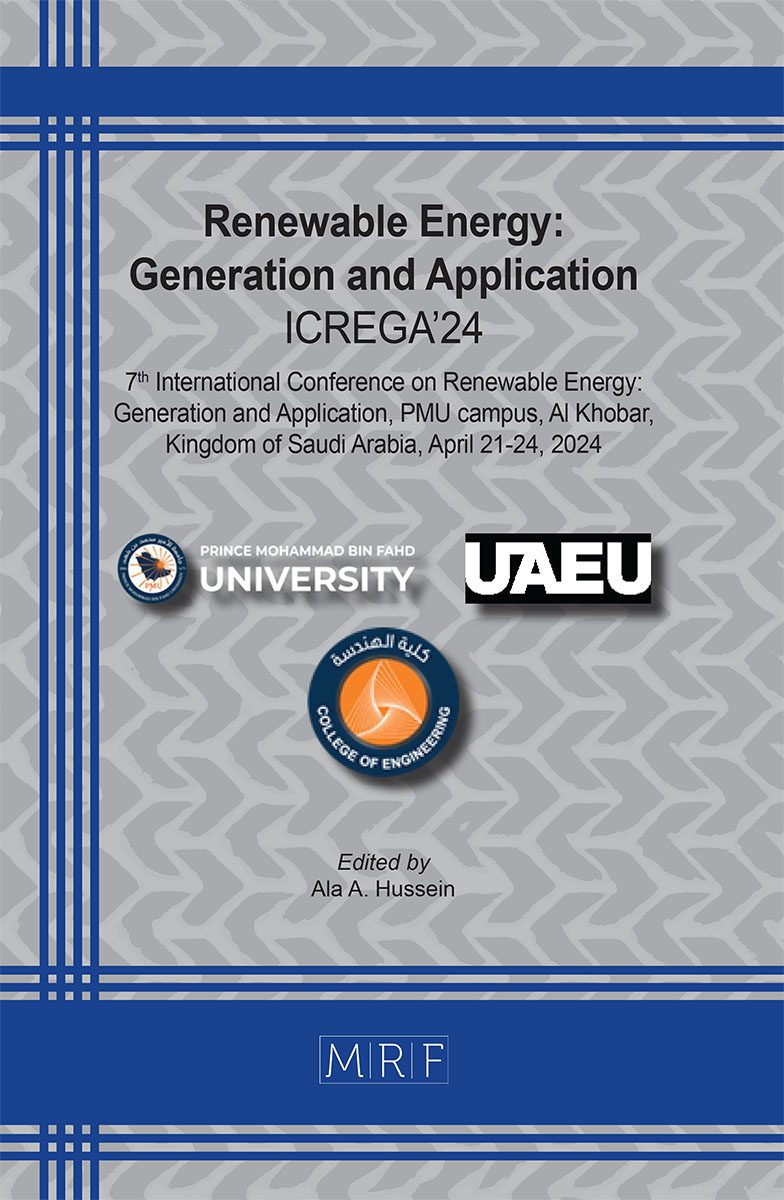–
Exploring sustainable micro milling: Investigating size effects on surface roughness for renewable energy potential
Ahmet HASCELIK, Kubilay ASLANTAS, Waleed AHMED
download PDFAbstract. Micromilling is a helpful process empowering the fabrication of small-scale components characterized by complex geometries, heightened precision, and superior surface integrity. Widely embraced across aerospace, biomedical, and electronics sectors, it characterizes efficiency and sustainability in modern manufacturing paradigms. However, fundamental instabilities emerge during the cutting phase, particularly when the size effect diminishes below a critical threshold termed the minimum chip thickness, a parameter linked to the cutting-edge radius and feed rate dynamics. The micro-milling process enables the production of small-scale parts with complex geometries, high precision, and optimal surface quality. It stands as a preferred production method not only in the aerospace, biomedical, and electronics industries but also in the renewable energy sector, where its ability to create intricate components with precise dimensions and superior surface quality is crucial for optimizing efficiency and sustainability in energy harvesting and storage technologies. Instabilities are observed in the cutting process when the size effect falls below a critical value known as the minimum chip thickness. This critical value is related to the cutting-edge radius and feed rate. This study investigates the effect of size on surface roughness in micro-milling of Al6061-T6 workpiece. The results show that surface roughness is high at feed rates below the minimum chip thickness due to the ploughing mechanism. The shear mechanism is active at feed rates above the minimum chip thickness, but the ploughing effect is still observed at the 100µm edge of the cutting channel. The study revealed that surface roughness and height differences were high at feed rates significantly below or above the minimum chip thickness. However, surface quality was optimal at feed rates near the minimum chip thickness. Nevertheless, the study highlights an optimal peak in surface quality achieved at feed rates close to the minimum chip thickness, explaining a relationship between operational efficiency and sustainability in micro-milling endeavours.
Keywords
Sustainable Micro-Milling, Size Effect, Surface Roughness, Minimum Chip Thickness
Published online 7/15/2024, 8 pages
Copyright © 2024 by the author(s)
Published under license by Materials Research Forum LLC., Millersville PA, USA
Citation: Ahmet HASCELIK, Kubilay ASLANTAS, Waleed AHMED, Exploring sustainable micro milling: Investigating size effects on surface roughness for renewable energy potential, Materials Research Proceedings, Vol. 43, pp 132-139, 2024
DOI: https://doi.org/10.21741/9781644903216-18
The article was published as article 18 of the book Renewable Energy: Generation and Application
![]() Content from this work may be used under the terms of the Creative Commons Attribution 3.0 license. Any further distribution of this work must maintain attribution to the author(s) and the title of the work, journal citation and DOI.
Content from this work may be used under the terms of the Creative Commons Attribution 3.0 license. Any further distribution of this work must maintain attribution to the author(s) and the title of the work, journal citation and DOI.
References
[1] Aslantas, K., Demir, B., Guldibi, AS., Niinomi, M, Dikici, B., A comparative study on the machinability of β-type novel Ti29Nb13Ta4.6Zr (TNTZ) biomedical alloys under micro-milling operation, Journal of Manufacturing Processes 92 (2023) 135-146. https://doi.org/10.1016/j.jmapro.2023.02.043
[2] Boswell, B., Islam, M.N., Davies, I.J., A review of micro-mechanical cutting, Int. J. Adv. Manuf. Technol. 94 (2018) 789-806. DOI: 10.1007/s00170-017-0912-y
[3] Balazs, B.Z., Geier, N., Takacs, M., Davim, J.P., A review on micro-milling: recent advances and future trends, Int. J. Adv. Manuf. Technol. 112 (2020) 655-84. DOI: 10.1007/s00170-020-06445-w
[4] Fu, M.W., Wang, J.L., Size effects in multi-scale materials processing and manufacturing, Int. J. Mach. Tool. Manuf. 167 (2021) 103755. DOI: 10.1016/j.ijmachtools.2021.103755
[5] Dib, M.H.M., Duduch, J.G., Jasinevicius, R.G., Minimum chip thickness determination by means of cutting force signal in micro endmilling, Precis. Eng. 51 (2018) 244–62. 10.1016/j.precisioneng.2017.08.016
[6] Wan, M., Ma, Y.C., Feng, J., Zhang, W.H., Study of static and dynamic ploughing mechanisms by establishing generalized model with static milling forces, Int. J. Mech. Sci., 114 (2016) 120-31.
[7] Krajewska-Spiewak, J., Maruda, R.W., Krolczyk, G.M., Nieslony, P., Wieczorowski, M., Gawlik, J. Wojciechowski, S., Study on ploughing phenomena in tool flank face – workpiece interface including tool wear effect during ball-end milling, Tribology International 181 (2023) 108313.
[8] Cheng, K., Huo, D., Micro-cutting: fundamentals and applications (First Edition), Chichester UK, John Wiley & Sons Ltd. (2013). DOI: 10.1002/9781118536605
[9] Aslantas, K., Danish, M., Hasçelik, A., Mia M., Gupta M., Ginta T., Ijaz H., Investigations on Surface Roughness and Tool Wear Characteristics in Micro-turning of Ti-6Al-4V Alloy, Materials 13 (2020) 2998. https://doi.org/10.3390/ma13132998
[10] Park, S. S., Malekian, M., Mechanistic Modeling and Accurate Measurement of Micro End Milling Forces, CIRP Annals-Manufacturing Technology 58 (2009) 49-52. https://doi.org/10.1016/j.cirp.2009.03.060
[11] Chen, Y., Wang, T., Zhang, G., Research on Parameter Optimization of Micro-Milling Al7075 Based on Edge-Size-Effect, Micromachines 11 (2020) 197. https://doi.org/10.3390/mi11020197
[12] Wu, X., Liu, L., Du, M., et al., Experimental Study on the Minimum Undeformed Chip Thickness Based on Effective Rake Angle in Micro Milling, Micromachines 11 (2020) 924. https://doi.org/10.3390/mi11100924
[13] Chae, J., Park, S.S., Freiheit, T., Investigation of Micro-Cutting Operations, International Journal of Machine Tools and Manufacture 46 (2006) 313-332. https://doi.org/10.1016/j.ijmachtools.2005.05.015
[14] Sun, X., Cheng, K., Micro/Nano-Machining through Mechanical Cutting (2010). https://dx.doi.org/10.1016/B978-0-8155-1545-6.00002-8
[15] Sun, Z., To, S., Zhang, S., Zhang G., Theoretical and experimental investigation into non-uniformity of surface generation in micro-milling, International Journal of Mechanical Sciences, 140 (2018) 313-324. https://doi.org/10.1016/j.ijmecsci.2018.03.019
[16] Akram, S., Jaffery, S., Khan, M., et.al., Numerical and experimental investigation of Johnson–Cook material models for aluminum (Al 6061-T6) alloy using orthogonal machining approach, Advances in Mechanical Engineering 10 (2018) 1-14. https://doi.org/10.1177/1687814018797794
[17] Wakchaure, K., Chaudhari, R., Thakur, A., Fuse, K., Lopez de Lacalle, L.N., Vora, J., The Effect of Cooling Temperature on Microstructure and Mechanical Properties of Al 6061-T6 Aluminum Alloy during Submerged Friction Stir Welding, Metals 13 (2023) 1159. https://doi.org/10.3390/met13071159












